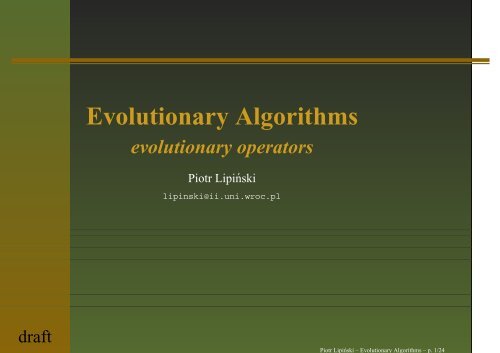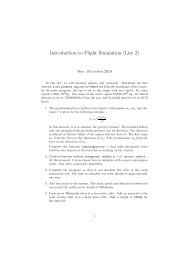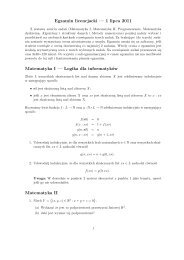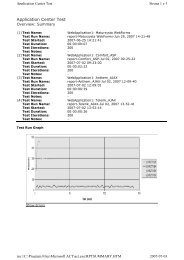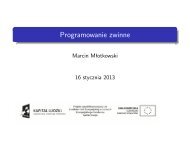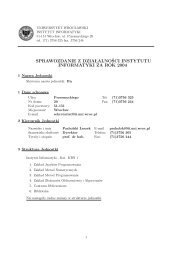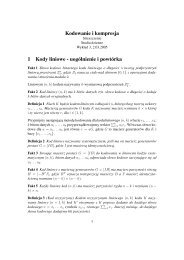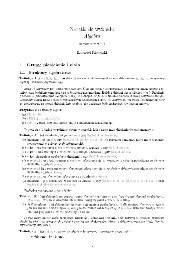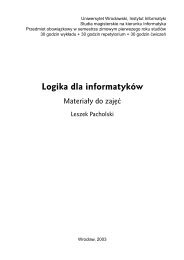Algorytmy ewolucyjne
Algorytmy ewolucyjne
Algorytmy ewolucyjne
Create successful ePaper yourself
Turn your PDF publications into a flip-book with our unique Google optimized e-Paper software.
Evolutionary Algorithms<br />
evolutionary operators<br />
Piotr Lipiński<br />
lipinski@ii.uni.wroc.pl<br />
draft<br />
Piotr Lipiński – Evolutionary Algorithms – p. 1/24
Examples of EAs<br />
SSGA<br />
SGA<br />
CGA<br />
PBIL<br />
ECGA<br />
GAs for graphs and objects partitioning<br />
draft<br />
Piotr Lipiński – Evolutionary Algorithms – p. 2/24
General schema of the EA<br />
EVOLUTIONARY-ALGORITHM(F,N)<br />
1 P ← RANDOM-POPULATION(N);<br />
2 POPULATION-EVALUATION(P,F);<br />
3 while not TERMINATION-CONDITION(P)<br />
4 do<br />
5 EVOLUTIONARY-OPERATOR-1(P);<br />
6 EVOLUTIONARY-OPERATOR-2(P);<br />
7 EVOLUTIONARY-OPERATOR-3(P);<br />
8 ...<br />
9 EVOLUTIONARY-OPERATOR-K(P);<br />
10 POPULATION-EVALUATION(P,F);<br />
draft<br />
Piotr Lipiński – Evolutionary Algorithms – p. 3/24
Benchmark functions<br />
OneMax – the number of ones in the binary vector<br />
Pattern – the number of places, where the binary vector is identical<br />
with a given pattern<br />
DeceptiveOneMax – the number of ones in the binary vector,<br />
except the binary vector of zeros, where the value is the length of the<br />
vector plus one<br />
K-DeceptiveOneMax – the sum of DeceptiveOneMax over<br />
successive blocks ofK coordinates of the binary vector<br />
draft<br />
Piotr Lipiński – Evolutionary Algorithms – p. 4/24
SSGA<br />
SIMPLIFIED-SIMPLE-GENETIC-ALGORITHM(F,N,M)<br />
1 P ← RANDOM-POPULATION(N);<br />
2 POPULATION-EVALUATION(P,F);<br />
3 while not TERMINATION-CONDITION(P)<br />
4 do<br />
5 BLOCK-SELECTION(P,M);<br />
6 UNIFORM-CROSSOVER(P);<br />
7 POPULATION-EVALUATION(P,F);<br />
draft<br />
Piotr Lipiński – Evolutionary Algorithms – p. 5/24
SGA<br />
SIMPLE-GENETIC-ALGORITHM(F,N,M,θ C ,θ M )<br />
1 P ← RANDOM-POPULATION(N);<br />
2 POPULATION-EVALUATION(P,F);<br />
3 while not TERMINATION-CONDITION(P)<br />
4 do<br />
5 P (P) ← PARENT-SELECTION(P,M);<br />
6 P (C) ← CROSSOVER(P (P) ,θ C );<br />
7 MUTATION(P (C) ,θ M );<br />
8 REPLACEMENT(P,P (C) );<br />
9 POPULATION-EVALUATION(P,F);<br />
draft<br />
Piotr Lipiński – Evolutionary Algorithms – p. 6/24
Selection and Reproduction<br />
selection is sometimes not considered as an evolutionary<br />
operator, although it has a strong influence on the algorithm<br />
selection may be applied BEFORE as well as AFTER the other<br />
evolutionary operators<br />
when selection is applied BEFORE the other evolutionary<br />
operators, the process of creating the new population is<br />
referred to as REPRODUCTION<br />
generational EA vs. steady-state EA<br />
draft<br />
Piotr Lipiński – Evolutionary Algorithms – p. 7/24
Selection and Reproduction<br />
example of a steady-state EA:<br />
- select two parent individuals,<br />
- produce two offspring individuals,<br />
- replace two worst individuals in the population with the two<br />
offspring individuals,<br />
- repeat the above process until the termination criteria,<br />
REMARK: only two individuals concerned in each iteration,<br />
not the entire population,<br />
PROBLEM: how to compare a steady-state EA with a<br />
generational EA (in terms of the computational complexity or<br />
time) ?<br />
draft<br />
Piotr Lipiński – Evolutionary Algorithms – p. 8/24
Selection and Reproduction<br />
some individuals may be sometimes transferred to the next<br />
population without applying any evolutionary operators,<br />
generation gap is the fraction of the population replaced in<br />
each iteration (e.g. 1.0 when the entire population is replaced),<br />
the best individuals may be sometimes automatically included<br />
in the next population (so-called elitism),<br />
draft<br />
Piotr Lipiński – Evolutionary Algorithms – p. 9/24
Fitness Function<br />
LetP = {x 1 ,x 2 ,...,x N } be a population.<br />
One may assign to each individual x i ,i = 1,2,...,N a value<br />
f(x i ) =<br />
F(x i )−F min<br />
∑ N<br />
j=1 (F(x j)−F min ) ,<br />
whereF min = min{F(x 1 ),F(x 2 ),...,F(x N )}, called the<br />
fitness value of the individual x i in the population P.<br />
The function f is called the fitness function.<br />
It is easy to see that<br />
0 ≤ f(x i ) ≤ 1 oraz<br />
N∑<br />
f(x j ) = 1.<br />
draft<br />
j=1<br />
Piotr Lipiński – Evolutionary Algorithms – p. 10/24
Selection According to the Fitness<br />
Function<br />
sometimes referred to as the roulette wheel method<br />
for each individual, the fitness value is evaluated and it defines<br />
the probability of selection for this individual<br />
PROBLEM: the domination of some super-individuals in the<br />
first iterations and a weak convergence in the next iterations.<br />
in order to avoid such a problem, fitness function scaling may<br />
be introduced<br />
draft<br />
Piotr Lipiński – Evolutionary Algorithms – p. 11/24
Fitness Function Scaling<br />
draft<br />
Simple scaling The fitness value of the i-th individual is given<br />
by<br />
f scaled (t) = f original (t)−f worst (t),<br />
where t is the number of iteration and f worst (t) is the worst<br />
objective value found so far<br />
Sigma scaling The fitness value of the i-th individual is given<br />
by<br />
f scaled (t) = f original (t)−( ¯ f(t)−cσ f (t)),<br />
if it is a positive value or 0 otherwise, wherecis a constant<br />
(e.g. 2), f(t) ¯ is the average fitness in the current population and<br />
σ f (t) is the standard deviation.<br />
Piotr Lipiński – Evolutionary Algorithms – p. 12/24
Fitness Function Scaling<br />
Power scaling The fitness value of the i-th individual is given<br />
by<br />
f scaled (t) = (f original (t)) k ,<br />
for k > 0.<br />
Exponential scaling The fitness value of the i-th individual is<br />
given by<br />
f scaled (t) = exp(f original (t)/T),<br />
where T > 0, called the temperature, is descending to 0 in<br />
successive iterations.<br />
draft<br />
Piotr Lipiński – Evolutionary Algorithms – p. 13/24
Ranking methods<br />
Linear ranking Assuming that the population size is µ, the<br />
worst individual has the rang0, the best one has the rangµ−1.<br />
The probability of selection of the i-th individual is:<br />
P linear (i) =<br />
α+(rank(i)/(µ−1))(β −α)<br />
,<br />
µ<br />
where α and β are parameters, denoting the expected number<br />
of offspring individual produced by the worst and the best<br />
individual, respectively. It is easy to see that<br />
∑ µ−1<br />
i=0 P linear(i) = 1, so α+β = 2, hence1 ≤ β ≤ 2 and<br />
α = 2−β.<br />
draft<br />
Piotr Lipiński – Evolutionary Algorithms – p. 14/24
Ranking methods<br />
Power ranking C is a normalization coefficient,0 < α < β,<br />
P power (i) = α+(rank(i)/(µ−1))k (β −α)<br />
.<br />
C<br />
draft<br />
Piotr Lipiński – Evolutionary Algorithms – p. 15/24
Recombination for continuous representations<br />
no recombination – copying the entire chromosome from one<br />
selected parent<br />
Uniform Crossover<br />
x i = b ki<br />
for a randomly chosen k i ∈ {1,2,...,ρ}, u ∈ (0,1)<br />
Discrete Recombination<br />
classic crossover (like in SGA) for vectors of numbers<br />
draft<br />
Piotr Lipiński – Evolutionary Algorithms – p. 16/24
Recombination for continuous representations<br />
Global Intermediary Recombination each offspring gene is the<br />
average of all the parent genes<br />
ρ∑<br />
x i = 1 ρ<br />
b ki<br />
k=1<br />
Local Intermediary Recombination each offspring gene is the<br />
average of two randomly chosen parents<br />
x i = u i b k1 i +(1−u i )b k2 i<br />
where k 1 ,k 2 ∈ {1,2,...,ρ}, u ∈ (0,1) are randomly chosen,<br />
draft<br />
Piotr Lipiński – Evolutionary Algorithms – p. 17/24
Recombination for discreet representation<br />
Multi-Point Recombination<br />
Global Discrete Recombination similar to uniform crossover<br />
for binary representation<br />
draft<br />
Piotr Lipiński – Evolutionary Algorithms – p. 18/24
Intermediary Recombination<br />
with two parents x 1 , x 2 ,<br />
x ′ i = αx 1i +(1−α)x 2i , α ∈ [0,1]<br />
with many parents x 1 , x 2 ,...,x n ,<br />
where ∑ i α i = 1.<br />
x ′ i = α 1 x 1i +α 2 x 2i +...+α n x ni<br />
draft<br />
Piotr Lipiński – Evolutionary Algorithms – p. 19/24
Other recombinations<br />
Heuristic recombination Letx 2 be not worse than x 1<br />
x ′ = u(x 2 −x 1 )+x 2<br />
where u ∈ [0,1] is a uniform distributed random number.<br />
Simplex Recombination First, randomly select a group of at<br />
least 2 parents. Letx 1 be the best and x 2 be the worst parent.<br />
Next, evaluate the centercof the group of parents and<br />
x ′ = c+(c−x 2 )<br />
Geometric Recombination (it may be generalized to many<br />
parents also)<br />
draft<br />
x ′ = ( √ x 11 x 21 , √ x 12 x 22 ,...)<br />
Piotr Lipiński – Evolutionary Algorithms – p. 20/24
Quadratic Recombination<br />
Letx ij be the j-th gene of the chromosome x i , for<br />
i = 1,2,3,j = 1,2,...,n where n is the chromosome length and<br />
x 4,j = 1 2 · (x2 2j −x 2 3j)f(x 1 )+(x 2 3j −x 2 1j)f(x 2 )+(x 2 1j −x 2 2j)f(x 3 )<br />
(x 2j −x 3j )f(x 1 )+(x 3j −x 1j )f(x 2 )+(x 1j −x 2j )f(x 3 )<br />
is the offspring individual produced by the 3 parent individuals x 1 ,<br />
x 2 ,x 3 .<br />
draft<br />
Piotr Lipiński – Evolutionary Algorithms – p. 21/24
Hybrid EA with Local Search<br />
Generate the initial population of µ individuals at random.<br />
Perform local search for each individual.<br />
REPEAT<br />
Generate three points P 1 ,P 2 ,P 3 using Global Discrete<br />
Recombination<br />
Use Quadratic Recombination with P 1 ,P 2 ,P 3 to produce P 4<br />
Perform local search forP 4<br />
Add P 1 ,P 2 ,P 3 ,P 4 to the current population and delete 4<br />
selected individuals from the current population (e.g. by<br />
deterministic selection).<br />
draft<br />
UNTIL termination condition<br />
Piotr Lipiński – Evolutionary Algorithms – p. 22/24
Local Search with Random Memorising<br />
Save the best solution in the memory.<br />
Take a randomly chosen saved solution (x old ) where a new<br />
solution x new outperforming the current population is found.<br />
Perform a search in the direction old → new, i.e. in the<br />
direction<br />
x new −x old<br />
||x new −x old ||<br />
draft<br />
Piotr Lipiński – Evolutionary Algorithms – p. 23/24
Experiments<br />
18 benchmark functions<br />
Population of 30 individuals<br />
50 trials for each benchmark<br />
draft<br />
Piotr Lipiński – Evolutionary Algorithms – p. 24/24


